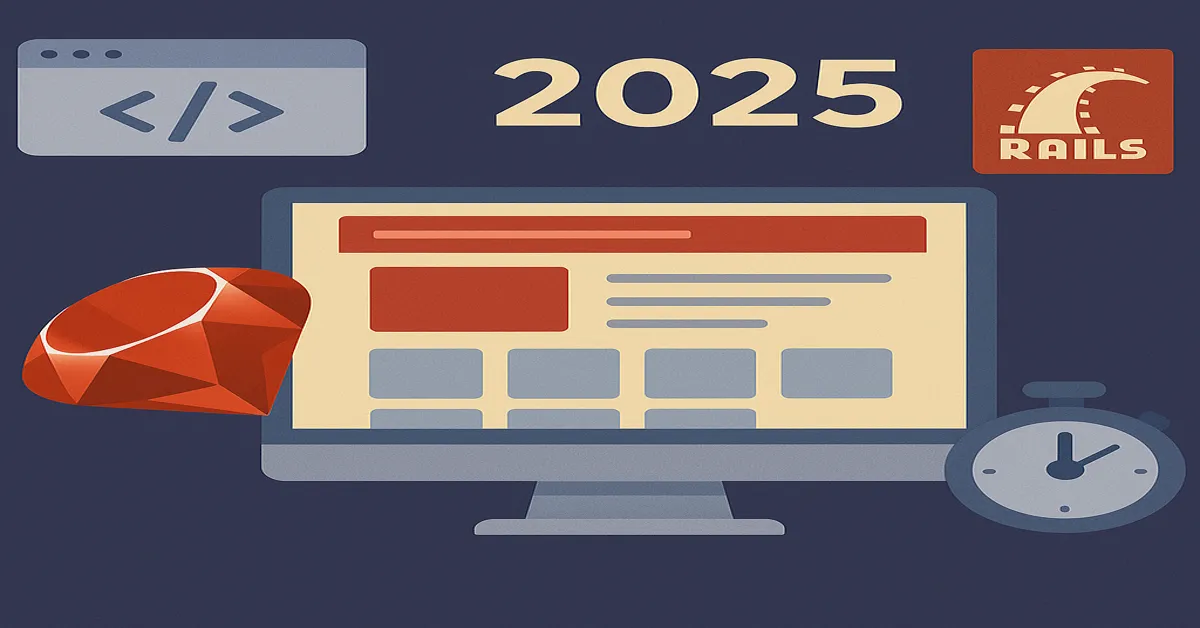In today’s venture environment, speed is more than a competitive edge—it’s survival. Startups and innovation teams are under increasing pressure to validate ideas, engage users, and pivot before the market shifts. In this high-stakes, high-speed climate, building a minimum viable product (MVP) swiftly, without sacrificing quality, is not just advisable—it’s foundational – Fast MVPs.
Ruby on Rails, a framework that once revolutionized web development with its “convention over configuration” mantra, continues to evolve. In 2025, it stands as one of the most effective and efficient technologies for bringing MVPs to life. Despite the emergence of newer JavaScript stacks and the growing complexity of frontend-driven frameworks, Rails holds its ground by offering what few frameworks can: fast iteration, full-stack development, and built-in scalability paths.
This article explores how to build MVPs at startup speed using Ruby on Rails in 2025. We’ll cover modern Rails features, updated tooling, practical strategies, and philosophies that prioritize speed without compromising technical soundness.
Why Ruby on Rails Still Matters in 2025
The software world doesn’t sit still. New frameworks surface every year, each promising faster performance or more developer joy. Yet Ruby on Rails has maintained its relevance—not because it’s the newest, but because it consistently evolves while keeping its core promise: to let developers build powerful applications quickly and sustainably.
The Rails Philosophy: Convention, Simplicity, and Velocity
Ruby on Rails prioritizes convention over configuration, meaning that many decisions are made for you. This reduces the cognitive load and lets developers focus on application logic rather than plumbing. The Rails “batteries-included” approach provides a wide range of tools out of the box—authentication, database migrations, API support, caching, background jobs, and more—making it ideal for fast MVPs.
2025 Enhancements That Matter
Rails 8.0, released in late 2024, introduced several features that significantly enhance MVP development:
- Turbo 8 and Hotwire+ for near real-time frontends without JavaScript-heavy stacks.
- Streamlined API-only modes with native JSON schema validation.
- Improved ActiveRecord encryption for zero-setup secure fields.
- Parallel job processing for better background performance.
Together, these features empower developers to go from concept to production faster than ever.
Step 1: Start with the Right Mindset
Creating a successful MVP is more than writing code. It’s about validating a hypothesis. Ruby on Rails supports this lean mindset because it removes much of the infrastructure friction. Still, how you approach the project is just as important as the tools you use.
Define the Core Problem
Your MVP should solve one clear, painful problem for a specific group of users. Rails helps you avoid distraction with its opinionated structure—you’ll spend less time organizing your code and more time solving user needs.
Prioritize Features Ruthlessly
The Rails scaffold generators and model-view-controller (MVC) patterns allow you to add features quickly. But that speed is a double-edged sword. Use it to focus, not to overbuild.
Step 2: Set Up the MVP Architecture
A strong technical foundation sets the tone for a project—even if it’s minimal.
Use Rails 8.0 (or Later)
As of 2025, Rails 8.0 should be your baseline. It’s optimized for both monoliths and service-oriented apps. Installation remains simple:
bashCopyEditrails new my_mvp_app --css=tailwind --database=postgresql --skip-javascript
This gives you a modern stack with Tailwind CSS and PostgreSQL, while Hotwire handles dynamic UI needs.
Structure for Growth
Even for MVPs, it’s worth creating a clean structure:
- Services: Extract business logic into service objects.
- Presenters: Separate view logic to keep controllers lean.
- Form Objects: Encapsulate validations, especially for complex forms.
- API Mode (optional): Use
rails new my_api --apifor mobile or SPA-focused MVPs.
These practices require little setup and offer significant long-term value.
Step 3: Build Core Features with Turbo and Hotwire+
In 2025, JavaScript-heavy frontends are still popular, but many MVPs don’t need them. Turbo and Hotwire+ (a major evolution of Hotwire introduced with Rails 8.0) allow you to build highly dynamic interfaces without leaving Ruby.
Real-Time Without React
Turbo Frames and Streams make it possible to:
- Update parts of the page dynamically.
- Submit forms and reflect changes instantly.
- Handle broadcasted updates (chat, notifications, etc.) with minimal setup.
Example: A form submission that updates a task list in real time, no JavaScript written manually.
erbCopyEdit<%= turbo_frame_tag "task_#{task.id}" do %>
<%= render task %>
<% end %>
Pair that with a Turbo Stream broadcast:
rubyCopyEditTurbo::StreamsChannel.broadcast_replace_to "tasks",
target: "task_#{task.id}",
partial: "tasks/task",
locals: { task: @task }
You now have a dynamic UI that rivals SPAs—with 10% of the effort.
Step 4: Leverage Built-In Rails Features
Rails includes tools that most frameworks leave out. This reduces dependency overhead and speeds up development.
Authentication with Devise or Sorcery
For most MVPs, you’ll need user authentication. The Devise gem remains a go-to, now with improved Turbo support. Alternatively, Sorcery offers a lighter-weight option.
Background Jobs with Sidekiq and ActiveJob
Want to send emails, handle payments, or sync data in the background? Use ActiveJob with Sidekiq:
rubyCopyEditclass NotificationJob < ApplicationJob
queue_as :default
def perform(user)
UserMailer.welcome_email(user).deliver_later
end
end
In 2025, Rails supports native multi-threaded job queues, improving performance without extra config.
Secure Fields with ActiveRecord Encryption
Handling sensitive data? Rails 8.0 supports field-level encryption by default:
rubyCopyEditclass User < ApplicationRecord
encrypts :email
encrypts :ssn, deterministic: true
end
No need for third-party libraries. Encryption is zero-setup and GDPR-compliant.
Step 5: Use Tailwind CSS for UI Speed
Tailwind CSS remains the fastest way to build clean, responsive UIs in 2025. With tight integration in Rails, you can design directly in your views:
erbCopyEdit<div class="bg-white rounded-xl p-4 shadow-md">
<h2 class="text-lg font-semibold">Welcome</h2>
<p class="text-gray-600">Start building your MVP here.</p>
</div>
Avoid heavy component libraries at the MVP stage—Tailwind gives you speed and flexibility.
Step 6: Testing, Error Tracking, and Metrics
Just because it’s an MVP doesn’t mean quality should suffer.
Use RSpec and FactoryBot
RSpec is the de facto testing tool in the Ruby community. Combine it with FactoryBot and Faker for data:
rubyCopyEditRSpec.describe User do
it "has a valid factory" do
expect(build(:user)).to be_valid
end
end
Integrate Error Monitoring Early
Use tools like Sentry or Bugsnag to catch errors early. The Rails community now favors lightweight observability setups with minimal overhead.
Add Simple Analytics
For MVPs, start with:
- Plausible or Fathom for GDPR-compliant tracking.
- Ahoy or custom logging if you prefer in-app metrics.
The key is not to overdo it—just enough to validate your core assumptions.
Step 7: Deployment in 2025: Heroku, Fly.io, or Render?
Deployment in 2025 is no longer about renting VPS boxes and configuring Capistrano (though you still can). Modern deployment services offer zero-devops paths to production.
Heroku (Still Relevant)
Heroku remains the fastest way to go live. With buildpacks, database add-ons, and native Rails support, a simple git push heroku main still works.
Fly.io and Render
Fly.io has gained momentum for full-stack Rails deployments with Docker-like power and global scaling. Render is perfect for budget-friendly MVP hosting with simplicity similar to Heroku.
All three platforms offer:
- One-command deploys
- Built-in Postgres and Redis
- TLS, scaling, cron jobs
Choose based on your team’s needs and budget—but all are Rails-friendly.
Common Pitfalls and How to Avoid Them
Even with Rails’ speed, MVP builders make recurring mistakes. Here’s how to avoid them:
Overengineering
Stick to the essentials. Don’t add Kubernetes, background queues, or microservices unless you truly need them.
Neglecting UX
Rails makes form handling and error messaging simple. Use form_with, validations, and flash messages to improve UX quickly.
Ignoring Testing
Even basic tests save hours of debugging. Focus on model tests and a few high-level controller specs.
Case Study: Building a Productivity App MVP in 10 Days
To ground these concepts, consider a real-world use case: a productivity tool for freelancers to track time and tasks.
Stack:
- Rails 8.0
- Turbo, Hotwire+
- Tailwind CSS
- PostgreSQL
- Sidekiq for jobs
- Devise for auth
- Fly.io for deployment
Features (Phase 1):
- Sign-up/login
- Project creation
- Task list with drag-and-drop (via Stimulus)
- Timer tracking with background jobs
- Dashboard with recent activity
Outcome:
Working MVP deployed in under 10 days, with responsive UI, user authentication, and real-time updates. Feedback from test users gathered immediately, enabling fast iteration.
Conclusion: The Rails Edge in 2025
In an era where startup funding is tighter and user expectations higher, the ability to rapidly build, test, and iterate on ideas is everything. Ruby on Rails, in 2025, remains uniquely positioned to serve this need.
Its blend of convention, rich ecosystem, evolving features, and battle-tested foundations makes it the ideal platform for MVPs that are not just fast—but stable, scalable, and maintainable.
If you’re launching a new product, validating a startup idea, or even testing an internal tool—start with Rails. You’ll ship faster, iterate sooner, and make smarter decisions based on real user feedback. And that, ultimately, is what MVPs are all about.
Read:
Is It Still Worth to Learn Ruby in 2025?
Building DevOps Tools with Ruby: Vagrant, Heroku, and Beyond
Ruby vs Python in 2025: Which One Should You Learn for Web Development?
Hotwire Integration with Rails 7+: The Future of Full-Stack Ruby
CVE‑2025‑43857 in net‑imap: What Ruby Developers Need to Know
FAQs
1. Is Ruby on Rails still a good choice for MVPs in 2025?
Absolutely. Despite the popularity of newer frameworks, Rails continues to evolve and remains a top choice for MVPs thanks to its convention-over-configuration approach, full-stack capabilities, and new features like Turbo 8, native encryption, and improved job handling. These updates make building and deploying MVPs faster and more efficient than ever.
2. What makes Rails faster than other frameworks for MVP development?
Rails provides built-in tools for authentication, database migrations, background jobs, caching, and real-time features through Turbo. It reduces the need for third-party integrations and lets developers focus on building features, not infrastructure. Its opinionated structure minimizes setup time and decision fatigue, making it especially effective for rapid prototyping.
3. Do I need a front-end framework like React or Vue with Rails in 2025?
Not necessarily. With Turbo and Hotwire+, you can create dynamic, real-time interfaces using only Rails. These tools significantly reduce or even eliminate the need for complex frontend JavaScript frameworks, making Rails a strong option for full-stack MVPs without the overhead of React or Vue unless specifically required.
4. What’s the best way to deploy a Rails MVP in 2025?
Platforms like Fly.io, Render, and Heroku remain the fastest ways to deploy Rails apps in 2025. They offer modern features like automatic SSL, Postgres add-ons, background jobs, and Git-based deploys. Fly.io is ideal for performance-focused apps, Render balances ease and flexibility, while Heroku is perfect for rapid prototyping.
5. How much can I build with Rails in just a week for an MVP?
A lot. With Rails 8.0, you can build a functional MVP—including user authentication, dynamic UIs, data models, and deployment—within 7–10 days. The key is focusing on essential features and leveraging built-in Rails tools like generators, Turbo, Tailwind CSS, and ActiveJob to avoid boilerplate and accelerate delivery.











